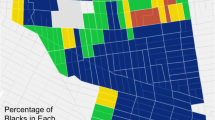Abstract
In discussions on the “fragmented city” and the boom of private and guarded neighbourhoods, several authors have stressed the importance of a growing differentiation of lifestyles and “cultural” orientations for this trend. The compounds for western foreigners in Saudi Arabia are explicitly based on the idea of a spatial seclusion of social groups with different “cultural” backgrounds. This study presents an overview of the development of these western enclaves. Narrative interviews with former expatriates provide insights into their daily life, their social relations within the compound, and to the Saudi Arabia behind the gates.


Similar content being viewed by others
Notes
The interviews were conducted and transcribed in French and German—citations in the text have been translated to English.
One of the biggest German construction companies.
References
Abu-Lughod, J. L. (1987). The Islamic city – historic myth, islamic essence, and contemporary relevance. International Journal of Middle East Studies, 19, 155–176
Barth, H., & Schliephake, L. (1998). Saudi-Arabien. Gotha & Stuttgart: Klett-Perthes
Bombacci, N. (1998). Ségrégation, trafic de papiers, expulsions; Préférence nationale à la saoudienne. Le Monde diplomatique, 535, 10
Bourgey, A. (1987). Les villes des émirats du golfe sont-elles encore des villes arabes? Cahier d’études arabes, 1, 7–26
Castells, M., & Mollenkopf, J. (1991). Conclusion: Is New York a dual city? In J. Mollenkopf & M. Castells (Eds.), Dual city. Restructuring New York (pp. 399–418). New York: Russell Sage Foundation
Courbage, Y. (2001). L’Arabie saoudite: une démographie en changement. Monde arabe – Maghreb Machrek, 174, 28–37
Dear, M. J., & Flusty, S. (1998). Postmodern urbanism. Annals of the Asscociation of American Geographers, 88(1), 50–72
Eickelman, D. F. (1974). Is there an Islamic city? The making of a quarter in a Moroccan town. International Journal of Middle East Studies, 5, 274–294
Fischer-Rosenthal, W., & Rosenthal, G. (1997). Warum Biographieanalyse und wie man sie macht. Zeitschrift für Sozialisationsforschung und Erziehungssoziologie, 17(4), 405–427
Glasze, G., & Alkhayyal, A. (2002). Gated housing estates in the Arab world: Case studies in Lebanon and Riyadh (Saudi Arabia). Environment and Planning B, 29(3), 321–336
Gulf News, 16 November (2003). Foreign workforce edgy after suicide bombings in Riyadh
Katar Gulf Times, 9 November (2003) Terrorist bombers strike Riyadh compound
Marcuse, P. (1989). Dual city: A muddy metaphor for a quartered city. International Journal for Urban and Regional Research, 13, 697–708
Meuter, N. (2004). Geschichten erzählen, Geschichten analysieren. Das narrativistische Paradigma in den Kulturwissenschaften. In F. Jaeger & B. Liebsch (Eds.), Handbuch der Kulturwissenschaften. Paradigmen und Disziplinen, Vol. 2 (pp. 140–155). Stuttgart & Weimar: J.B. Metzler
Meyer, G. (1991). Arbeitsmigration in die Golfregion und die Folgen des irakischen Überfalls auf Kuwait. Die Erde, 122, 81–96
Pape, H. (1977). Er Riad. Stadtgeographie und Stadtkartographie der Hauptstadt Saudi-Arabiens. Paderborn: Ferdinand Schöningh
Peißker-Meyer, C. F. (2001). Heimat auf Zeit. Europäische Frauen in der Arabischen Welt. transcript
Raymond, A., (1989). Espaces publiques et espaces privés dans les villes arabes traditionelles. Maghreb, Machrek, 123, 194–201
Raymond, A. (1994). Islamic city, Arab city: Orientalist myths and recent views. British Journal of Middle Eastern Studies, 21, 3–18
Süddeutsche Zeitung, 9 November (2003). Mehrere Tote bei Bombenanschlägen in Riad
Talib, K. (1984). Shelter in Saudi-Arabia. London: Martin’s Press
Wirth, E. (1992). The concept of the islamic city – privacy in the islamic east versus public life in western culture. Applied Geography and Development, 40, 22–38
Author information
Authors and Affiliations
Corresponding author
Rights and permissions
About this article
Cite this article
Glasze, G. Segregation and seclusion: the case of compounds for western expatriates in Saudi Arabia. GeoJournal 66, 83–88 (2006). https://doi.org/10.1007/s10708-006-9018-z
Received:
Accepted:
Published:
Issue Date:
DOI: https://doi.org/10.1007/s10708-006-9018-z




